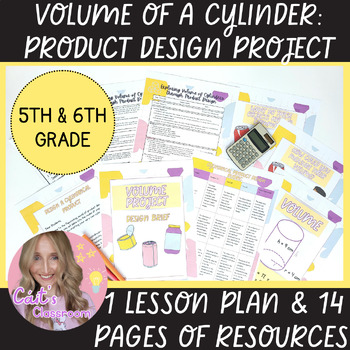Volume of Cylinders Math Lesson Plan│Volume Project & Rubric│5th & 6th Grade
- PDF
Also included in
- Looking for an engaging math unit on measuring the volume of 3D shapes that your fifth/sixth graders will love? Want step-by-step lesson plans, printable/digital games and activities and hands-on, project based learning and rubrics? Then this resource is for YOU!This unit is aligned with both CCSSMPrice $19.60Original Price $27.40Save $7.80
Description
Searching for an engaging lesson for fifth/sixth grade on the volume of cylinders using the metric system? Want it to include project-based learning and a detailed assessment rubric? Then this resource is for YOU!
Take the stress out of creating complete lesson plans and resources! This lesson includes a project design brief which encourages students to think critically and creatively while applying mathematical concepts to real-world situations.
This resource is also aligned with both CCSSM and the Irish Primary Mathematics Curriculum (2023) for seamless integration into planning documents.
Say goodbye to weekends planning on your laptop and hello to an engaged classroom – grab your copy TODAY!
Benefits
- Reduces planning demands on teachers, saving valuable time and effort while being well-designed and aligned with curriculum standards.
- Offers a complete, print-and-go resource with step-by-step instructions, ideal for newly qualified teachers who want support teaching math to the senior grades.
- Enhances conceptual understanding and procedural fluency in calculating, measuring and modelling cylinder volume.
In Depth Description
This 45-minute+ lesson plan includes:
- 3 posters on exploring the volume of a cylinder.
- 5 page product design brief and submission sheet (colour).
- 5 page product design brief and submission sheet (black & white)
- 2 page assessment rubric with 5 detailed categories for assessment.
- 3 learning objectives.
- Differentiation strategies for both struggling and advanced students.
- Formative and summative assessment ideas.
- Key vocabulary and definitions.
- Explicit links to the new Irish Primary Mathematics Curriculum (2023), specifically the element of understanding and connecting and the competencies of being mathematical, being an active learner and being an effective communicator.
- Explicit links with CCSSM.
5th Grade:
- CCSS.5.MD.C.3: Recognize volume as an attribute of solid figures and understand concepts of volume measurement.
- CCSS.5.MD.C.4: Measure volumes by counting unit cubes, using cubic cm, cubic in, cubic ft, and improvised units.
Mathematical Practice Standards:
- CCSS.MP.4: Model with mathematics
- CCSS.MP.5: Use appropriate tools strategically
- CSS.MP.6: Attend to precision
Don't let this opportunity slip away! Elevate your teaching experience and engage your students - secure your complete lesson plan and resources TODAY!
Click here to join the Cáit's Classroom mailing list for valuable tips, tricks, and special offers designed to support newly qualified teachers in effectively teaching maths to 3rd-6th class students.
Related Products
⭐ Cone/Pyramid Volume Lesson Plan │Worksheets, Game, Guided Practice│5th/6th Grade
⭐ Cube/Cuboid Volume Lesson Plan│Worksheets, Digital/Hands-On Activities │5th/6th
⭐ Cube/Cuboid Volume Lesson Plan│Worksheets, Games, Problem Solving│5th/6th Grade
⭐ Additive Volume Lesson Plan │Worksheets, Games, Guided Practice│5th/6th Grade






